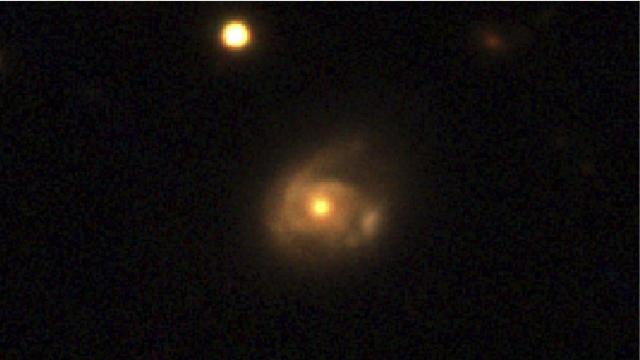On June 22, 2022, NASA’s Swift Observatory spotted something curious in a galaxy over 500 million light-years away. It was a routine outburst of gas that a team studying the data now believes is evidence of a black hole intermittently gobbling up a star each time the latter draws near.
The black hole and its star are collectively named Swift J023017.0+283603, or Swift J0230. The two sit in a galaxy called 2MASX J02301709+2836050, in a constellation Triangulum. Swift J0230 was observed by—you guessed it—the Swift Observatory, which launched in 2004, thanks to a new way of analyzing the telescope’s X-ray data. Analysis of the dynamic duo—an admittedly imbalanced one—was published yesterday in Nature Astronomy.
“Swift’s hardware, software, and the skills of its international team have enabled it to adapt to new areas of astrophysics over its lifetime,” said Phil Evans, an astrophysicist at the University of Leicester in the United Kingdom and a member of the Swift team, in a NASA release. “Neil Gehrels, the mission’s namesake, oversaw and encouraged many of those transitions. Now, with this new ability, it’s doing even more cool science.”
Despite their stoic countenance in films and images, black holes are hardly inert. They are some of the densest objects in the universe, and the environments surrounding them are extremely energetic. Black holes accrete matter around them in disks and gorge themselves on the superheated material that falls into their event horizons, the region beyond which not even light can escape them.
When a star becomes gravitationally ensnared by a black hole, the black hole leeches material off the star every time it comes near. The black hole feeds over time, in what’s known as a repeating tidal disruption event. Swift J0230 appears to be such an event, though it’s hardly the first; another recently observed repeating tidal disruption was observed in the object ASASSN-14ko back in 2021. Stars unfortunate enough to get caught in a black hole’s orbit but too far to be quickly devoured get locked into a death spiral with the more massive object.
In Swift J0230’s case, a black hole over 200,000 times the mass of the Sun is prying off three Earth masses’ worth of the star each time the latter object swings past. But it may not be the end of the star; previously, astronomers have seen black holes upchucking stellar material they consumed years earlier.
More work needs to be done to distinguish tidal disruption events from the reinvigoration of active galactic nuclei, or AGNs, which are supermassive black holes at the cores of galaxies that emit massive jets of material in energetic outbursts. From a distance, the demise of an unfortunate star can look a lot like a black hole waking up after a long slumber.
